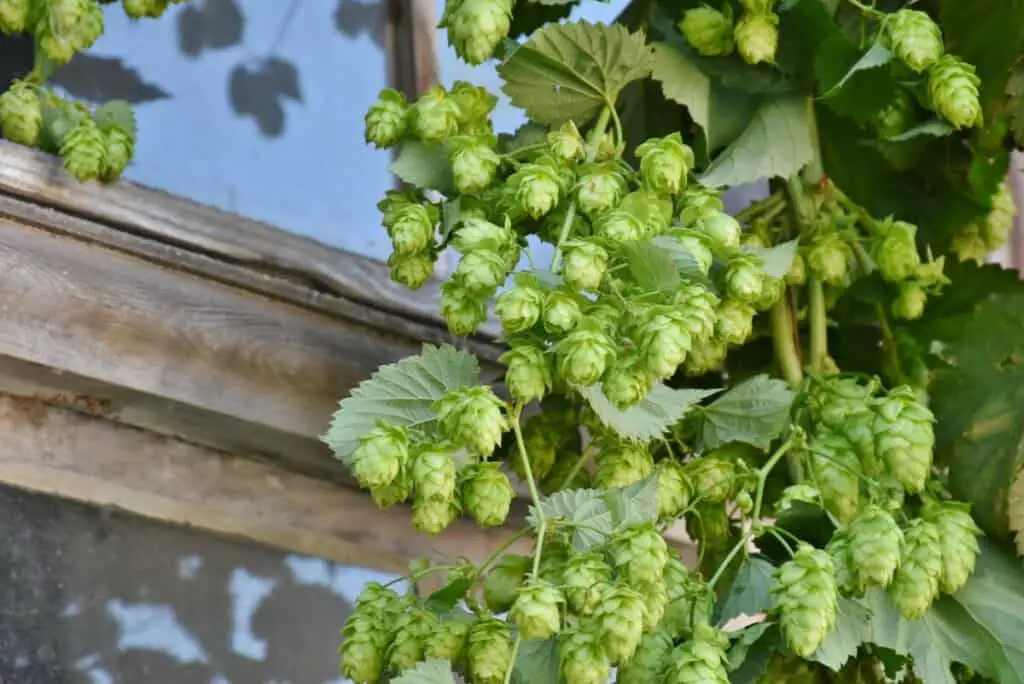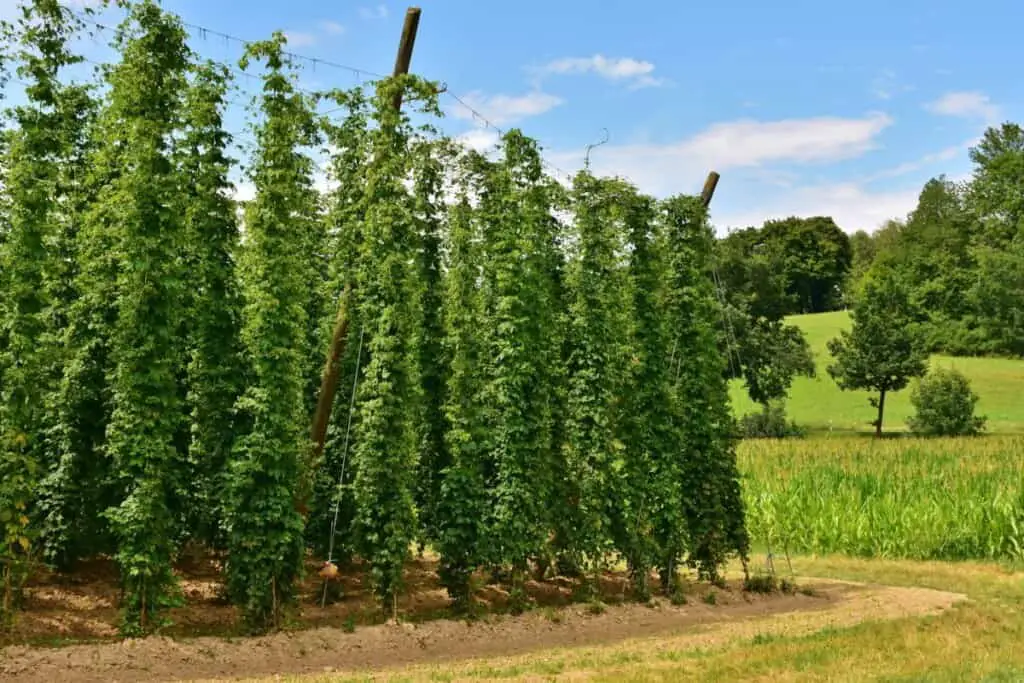
Are you thinking about growing your own hops to add to some homebrew? After tons of research, I learned something that I did not think about initially. You can add fresh hops to beer for great aroma. The problem was I didn’t know how much too add since the water content was so much more. I couldn’t exactly weigh it like hops pellets.
Fresh Hops contain 70% more water than dry leaf or pellet hops. So a ratio of 6 to 1 ounces is often used when deciding how many ounces of fresh hops to add. Fresh hops should be used for aroma rather than bittering since dried hops concentrate more alpha acids.
Dealing with fresh hops, or wet hops as they are often called can be a bit intimidating. Its a whole new ball game. That’s why I had to take the time to figure out what to expect when using fresh hops.
The Ratio of Dry Hops to Wet Hops
Fresh hops are often reffered to as wet hops. This is because their water content is much greater than the kind you would be getting from the homebrew store.
The problem with fresh hops is they are hard to obtain, they are essentially only available one time of year, during harvest in either August or September.
Use 6 ounces of fresh hops for every 1 ounce of dry hops.
When you get these fresh hops you have about 24 hours to brew with them before they become oxidized and the hop oils begin to degrade. They are at their freshest during the first 24 hours and you will get the very most out of its aroma.
Above I referred to the ratio of wet hops to dry hops. In order to accurately take one of your favorite recipes and adapt it.
That ratio I am coining as the green ratio. Get it because hops are green? Well that ratio is 6 to 1. I’m not sure why it isn’t 7 since wet hops have roughly 70% more water content, but its possible because their alpha acids have not degraded at all and thus are more potent.
How to Add Fresh Hops
There are a few different ways to utilize fresh hops in your homebrew. However they are mainly used for aroma and flavors. The reason why they are not used as much for bittering, is because there is something that happens with the alpha acids in the drying process that makes them more potent.
This is why you may want to use dry hops for bittering and fresh hops for aroma at the end of the boil and dry hopping. Although, you can most definitely use wet hops for bittering as well. Just remember the ratio of 6 to 1.
Adding fresh hops to your beer is fairly simple just follow these steps.
- Pick the hops lay them on a screen and shake it to remove any bugs.
- Use the hops within the next day, to ensure freshness.
- Convert your favorite recipe using the 6 to 1 ratio.
- Add the hops to your boil. Its better not to use a hop spider, since the free floating hops can be easily collected and not contribute to trub. This ensures you get the most out of the hops.
- You can dry hop with fresh hops, but its likely you will need to pick different hops, than you boiled with.
The Flavor Difference of Fresh Hops
Fresh hops will impart a much greener and vegetable flavor than dried hops. This makes them not great for every recipe. There are some recipes where they can shine, for example IPA’s.
Best Beer Styles to Use Fresh Hops
Not every beer style works great with fresh hops since they impart a much different effect than dried hops do, but there are many that benefit from it.
India Pale Ale
IPA is the obvious choice for any wet hop recipe. The India pale ale style of beer works perfectly by hitting those fruity notes. You can be free to toss in as many fresh hops as possible without worrying to much about bitterness.
If it’s not bitter enough for you with fresh hops you might want to use some dry hops for bittering. But if you are brewing up a NEIPA then you are golden.
Pale ales are a great choice as well since they are bitter and malty. The flavors should go nicely. If you have never brewed and IPA you can start with this 1 gallon kit from Adventures in Homebrewing. Swap out the hops for your own fresh hops at flameout or add extra fresh hops for added aroma at flameout.
Saison
The floral and bright freshness of wet hops make it perfect for a Saison style beer. Saison’s are more sour and acidic so it will bring out the fruitier notes in the fresh hops.
Get a jump on brewing a Saison to get ready for your next wet hop season. This Brooklyn Brew Shop kit looks perfect for a practice round and then you can replace the dry hops in the kit with wet hops for your second time, then check out the difference.
Experimentation is Key
Because these hops are only available once a year there really isn’t too much testing done on it. But anything that has a predominant hop flavor will work with fresh hops. It’s probably not a good choice to use it for any overly malty styles of beer, but the choice is up to you.
What Hop Varieties are the Best for Wet Hopping
There are a ton of different hop varieties but anything that you can get your hands on that is fresh will be great for wet hopping. You can go to local hop farms and ask to buy them fresh, or you can grow your own.
I would stay away from any hop varieties that are mainly labeled as bittering hops since its sort of a waste to use them for bittering. Look for any hop varieties that are duel use or for aroma and flavor.
Here is a list of some varieties that would be great for wet hopping.
- Cascade
- Centennial
- Chinook
- Crystal
These are typical aroma or dual use hops. According to HopRhizomes.com Cascade is the easiest for new hop growers to grow.

Grow Your Own Hops for Wet Hopping
Unfortunately you won’t be able to get any hop plant you want to grow. This is because some of the varieties were bred and can only be grown by those specific hop farmers.
If you are like me and live in America it might be pretty difficult to get your hands on some European style hops, so you might just have to stick to the American variety.
You can buy hop rhizomes from a number of places. Although they are usually only available in the spring. So bookmark this page you so can order them and get a jump on the growing season.
Disclaimer: Frugalhomebrew.com is compensated for referrals to Adventures in Homebrewing and Amazon.
If you live in hop growing regions you can probably find them at your local nursery but for those of us in other regions of the United States we are likely stuck to ordering them online.
